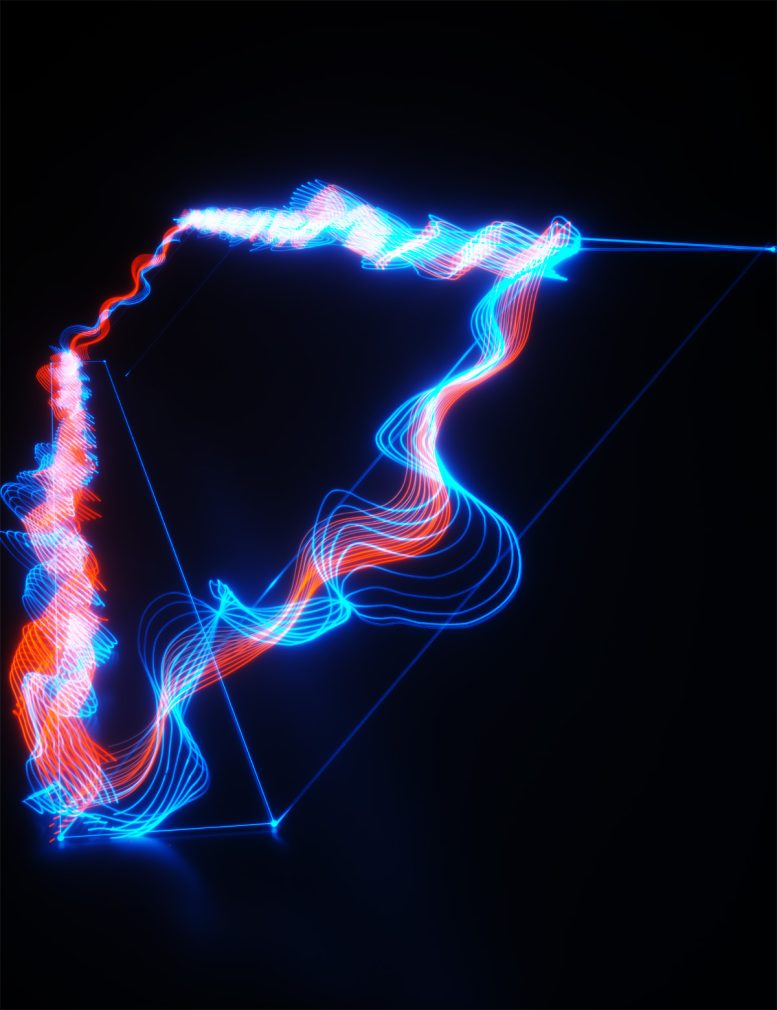
A schematic representation of quantum interference of the topological motion of electrons along the symmetry-allowed sample hinges. Credit: Shafayat Hossain, postdoctoral research associate in the Zahid Hasan group at Princeton University
New research expands opportunities for advancements in quantum physics and spintronics.
In a novel experiment, physicists have observed long-range quantum coherence effects due to Aharonov-Bohm interference in a topological insulator-based device. This finding opens up a new realm of possibilities for the future development of topological quantum physics and engineering. This finding could also affect the development of spin-based electronics, which may potentially replace some current electronic systems for higher energy efficiency and may provide new platforms to explore quantum information science.
The research, published in Nature Physics, is the culmination of more than 15 years of work at Princeton. It came about when Princeton scientists developed a quantum device — called a bismuth bromide (α-Bi4Br4) topological insulator — only a few nanometers thick and used it to investigate quantum coherence.
Scientists have used topological insulators to demonstrate novel quantum effects for more than a decade. The Princeton team developed their bismuth-based insulator in a previous experiment where they demonstrated its effectiveness at room temperature. But this new experiment is the first time these effects have been observed with a very long-range quantum coherence and at a relatively high temperature. Inducing and observing coherent quantum states typically requires temperatures near absolute zero on artificially designed semiconducting materials only in the presence of strong magnetic fields.
“Our experiments provide compelling evidence for the existence of long-range quantum coherence in topological hinge modes, thus opening new avenues towards the development of topological circuitry as well as using this topological method to explore and advance fundamental physics,” said M. Zahid Hasan, the Eugene Higgins Professor of Physics at Princeton University, who led the research. “Unlike conventional electronic devices, topological circuits are robust against defects and impurities, making them far less prone to energy dissipation, which is advantageous for greener applications.”
Topological states of matter and coherence
In recent years, the study of topological states of matter has attracted considerable attention among physicists and engineers and is presently the focus of much international interest and research. This area of study combines quantum physics with topology — a branch of theoretical mathematics that explores geometric properties that can be deformed but not intrinsically changed.
The main device used to investigate the mysteries of quantum topology is called a topological insulator. This is a unique device that acts as an insulator in its interior, which means that the electrons inside are not free to move around and therefore do not conduct electricity. However, the electrons on the device’s edges are free to move around, meaning they are conductive. Moreover, because of the special properties of topology, the electrons flowing along the edges are not hampered by any defects or deformations. A special type of topology is also possible in certain bismuth-based materials where some edges can be gapped and only some hinges remain conducting. A device made of such topological materials has the potential not only of improving technology but also of generating a greater understanding of matter itself by probing quantum properties in new and innovative ways.
Until now, however, the inability to achieve long coherence times has been a major stumbling block in the quest to use the materials for applications in functional devices. Coherence refers to the ability to maintain the quantum states of superposition and entanglement in the face of disruptive influences, such as thermalization or other interactions with the environment.
“There is a lot of interest in topological materials, and people often talk about their great potential for practical applications,” said Hasan, “but until some macroscopic quantum topological effect can be demonstrated to have long quantum coherence which may also operate at relatively high temperatures, these applications will likely remain unrealized. Therefore, we are in search of materials that exhibit long-range quantum coherence of topological electrons.”
The current experiment
Hasan’s team has been exploring bismuth-based topological materials for almost two decades. Recently, however, the team discovered that the bismuth bromide insulator has properties that make it more ideal compared to bismuth-based topological insulators (including Bi-Sb alloys) that they had studied since 2005. It has a large insulating gap of over 200 meV (milli-electron volts). This is large enough to overcome thermal noise, but small enough that it does not disrupt the spin-orbit coupling effect and band inversion topology. Bismuth bromide insulators belong to a class of topological insulators that also exhibit high-order effects whose surfaces become insulating, but the edges of some-symmetry-dictated orientations remain conducting. These are called hinge states which were recently theorized by collaborator and co-author Titus Neupert’s group at the University of Zurich.
“While it was not guaranteed in theory, through several years of experimentation we discovered that bismuth bromide’s hinge states have very long-range quantum coherence at relatively high temperatures. In this case, in our experiments based on the devices we fabricated, we found a balance between spin-orbit coupling effects, long-range quantum coherence, and thermal fluctuations,” said Hasan. “We found there is a ‘sweet spot’ where you can have a relatively high degree of quantum coherence of the topological hinge modes as well as operate at a relatively high temperature. It’s kind of like a balance point for the bismuth-based materials that we have been studying for almost two decades.”
Using a scanning tunneling microscope, the researchers observed a clear quantum spin Hall edge state, which is one of the important properties that uniquely exists in topological systems. This required additional novel instrumentation to uniquely isolate the topological effect.
Even though bismuth harbors such a quantum state, the material itself is a semimetal without any insulating energy gap. This makes it difficult to explore its consequence in electron transport because, in bismuth, the transport channels contain electrons from both the bulk and from the hinge states. They mix and blur the coherent quantum transport signal of the hinge states.
A further problem is caused by what physicists call “thermal noise,” which is defined as a rise in temperature such that the atoms begin to vibrate violently. This action can disrupt delicate quantum systems, thereby collapsing the quantum state. In topological insulators, in particular, these higher temperatures create a situation in which the electrons on the surface of the insulator invade the interior, or “bulk,” of the insulator, and cause the electrons there to also begin conducting, which dilutes or breaks the special quantum effect. Thermal fluctuations also destroy the quantum phase coherence of electrons.
But the bismuth bromide insulator developed by the team was able to bypass this and other problems. They used the device to demonstrate quantum coherent transport through the topological hinge modes. A hallmark of quantum coherent transport is the manifestation of the Aharonov–Bohm quantum interference. The Aharonov–Bohm interference, predicted almost 60 years ago (physicist David Bohm was at Princeton from 1947 to 1951), describes a phenomenon where a quantum wave is split into two waves that go around a closed path and interfere under the influence of an electromagnetic potential. The resulting interference pattern is determined by the magnetic flux enclosed by the waves. In the case of electrons, such a quantum interference occurs if the conduction electrons remain phase-coherent after completing closed trajectories, resulting in a periodic oscillation in electrical resistance with a characteristic period of the magnetic field ΔB = Φ0/S, where Φ0 = h/e is the flux quantum, S is the area over which the electron trajectories remain phase coherent, h is Planck’s constant and e is the electron charge. For the topological conduction channels, all phase coherent trajectories participating in the quantum interference enclose the same area perpendicular to the B field, which is different from the universal conductance fluctuations. Here they present magnetoresistance traces from the α-Bi4Br4 samples that show B-periodic oscillations, the hallmark of the Aharonov–Bohm effect stemming from phase coherent carriers.
“For the first time, we demonstrated that there’s a class of bismuth-based topological electron devices that can have a high degree of quantum coherence surviving up to relatively high temperature, which is due to the Aharonov–Bohm interference effect stemming from phase coherent topological electrons,” said Hasan.
The discovery’s topological roots lie in the workings of the quantum Hall effect — a form of topological effect that was the subject of the Nobel Prize in Physics in 1985. Since that time, topological phases have been intensely studied. Many new classes of quantum materials with topological electronic structures have been found, including topological insulators, topological superconductors, topological magnets, and Weyl semimetals. Experimental and theoretical discoveries have both continued. Daniel Tsui, the Arthur Legrand Doty Professor of Electrical Engineering Emeritus at Princeton, won the 1998 Nobel Prize in Physics for discovering the fractional quantum Hall effect, and F. Duncan Haldane, the Eugene Higgins Professor of Physics at Princeton, won the 2016 Nobel Prize in Physics for theoretical discoveries of topological phase transitions and a type of two-dimensional (2D) topological insulators. Subsequent theoretical developments showed that topological insulators can take the form of two copies of Haldane’s model based on electron’s spin-orbit interaction.
Hasan and his team have been on a decade-long search for a topological quantum state that can also preserve a high degree of quantum coherence at a relatively high temperature, following their discovery of the first examples of three-dimensional topological insulators in 2007. Recently, they found a solution to Haldane’s conjecture in a topological material that is capable of operating at room temperature, which also exhibits the desired quantization.
“A suitable atomic chemistry and structure design coupled to first-principles theory is the crucial step to make topological insulator’s speculative prediction realistic in a device setting to maintain long quantum coherence,” Hasan said. “There are many Bi-based topological materials, and we need both intuition, experience, materials-specific calculations, and intense experimental efforts to eventually find the right material for in-depth exploration in a device setting. And that took us on a decade-long journey of investigating some bismuth-based materials that eventually seem to be working.”
Implications for quantum materials
“We believe this finding may be the starting point of future development in quantum engineering and nanotechnology,” said Shafayat Hossain, a postdoctoral research associate in Hasan’s lab and a co-first author of the study. “There have been so many proposed possibilities in topological quantum science and engineering technology that await, and finding appropriate materials with long quantum coherence properties coupled with novel instrumentation is one of the keys for this. And that is what we achieved.”
“If the electrons are not bouncing around, or are agitated, they are not losing energy,” said Hasan. “This creates a quantum basis for energy saving or greener technologies because they are consuming much less power. But this is still a long way off.”
Currently, the theoretical and experimental focus of Hasan’s team is concentrated in two directions, said Hasan. First, the researchers want to determine what other topological materials might exhibit similar or higher level of quantum coherence, and, importantly, provide other scientists the tools and novel instrumentation methods to identify these materials that will operate at higher temperatures. Second, the researchers want to continue to probe deeper into the quantum world and search for new physics in a device setting. These studies will require the development of another set of new instruments techniques and topological devices to fully harness the enormous potential of these wonder materials.
Nan Yao, a co-author of the paper and professor of the practice at the Princeton Materials Institute summed up the research by saying, “This work on higher-order topological insulators exemplifies the beauty and importance of discovering new facets of nature, such as the quantum coherence of topological hinge states,” said Yao, the director of the Imaging and Analysis Center at Princeton. “It’s a discovery that could potentially lead to exciting advancements in quantum devices, and I’m reminded of Einstein’s famous quote, ‘The most beautiful thing we can experience is the mysterious. It is the source of all true art and science.’”
Reference: “Quantum transport response of topological hinge modes” by Md Shafayat Hossain, Qi Zhang, Zhiwei Wang, Nikhil Dhale, Wenhao Liu, Maksim Litskevich, Brian Casas, Nana Shumiya, Jia-Xin Yin, Tyler A. Cochran, Yongkai Li, Yu-Xiao Jiang, Yuqi Zhang, Guangming Cheng, Zi-Jia Cheng, Xian P. Yang, Nan Yao, Titus Neupert, Luis Balicas, Yugui Yao, Bing Lv and M. Zahid Hasan, 20 February 2024, Nature Physics.
DOI: 10.1038/s41567-024-02388-1
The team included a number of researchers from Princeton’s Department of Physics and Princeton’s Institute for Science and Technology of Materials, including Md Shafayat Hossain, Qi Zhang, Maksim Litskevich, Nana Shumiya, Jia-Xin Yin, Tyler A. Cochran, Yu-Xiao Jiang, Guangming Cheng, Zi-Jia Cheng, Xian P. Yang, Nan Yao, and M. Zahid Hasan. Additional researchers included Qi Zhang, of the Beijing Institute of Technology, and Yongkai Li, Ying Yang, and Yugui Yao, the latter three associated with both the Beijing Institute of Technology and the Chinese Academy of Sciences. Nikhil Dhale, Wenhao Liu, and Bing Lv are from the University of Texas at Dallas, while Brian Casas and Luis Balicas are from the National High Magnetic Field Laboratory, in Tallahassee, Florida. Titus Neupert is from the Department of Physics, University of Zurich, in Zurich, Switzerland.
The primary support for the work at Princeton is from the U.S. Department of Energy (DOE) Office of Science, the National Quantum Information Science Research Centers, the Quantum Science Center (at ORNL) and Princeton University. Additional support for STM Instrumentation and theory work came from the Gordon and Betty Moore Foundation (GBMF9461). Support was also supplied by the U.S. DOE under the Basic Energy Sciences program (grant number DOE/BES DE-FG-02-05ER46200) for the theory and sample characterization work including ARPES. Additional support is reported in the paper.

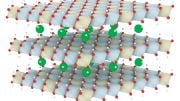
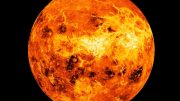
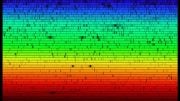

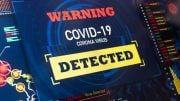
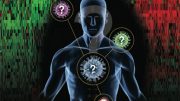
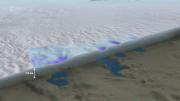
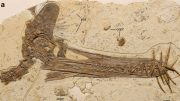
Very good! You found a balance between spin-orbit coupling effects, long-range quantum coherence, and thermal fluctuations.
Please think carefully,
1. Where does the force of orbital spin come from?
2. Where does the force of topological vortex spin come from?
3. Is spin-orbit related to topological vortices?
4. Is the spin of celestial bodies and galaxies related to topological vortices?
5. Can topology explain these spins?
6. Are so-called academic journals (such as Physical Review Letters, Nature, Science, etc.) scientific and honest?
7. Why are opposed and hated the following statements by some people and so-called academic journals?
and so on.
The universe does not do algebra, formula or fraction. The universe is geometrythe,and is the superposition, deflection, and twisting of geometric shapes.
Today, we have already entered the era of the internet. With the help of artificial intelligence and big data, discussions on scientific knowledge have become open and transparent. However, a group of editors of so-called academic journals (such as Physical Review Letters, Nature, Science, etc.) are self-righteous and mystifying themselves. They only care about their own so-called sufficiently high priority rating, general significance, discipline, novelty, etc., and do not care about what science and pseudoscience are.
Science and pseudoscience are not determined by a publication, an organization or a person, nor by you or me, but by mathematics the final say. Physical models must be based on mathematics or mathematical models in order to be scientific, convincing, and in accordance with natural laws.
The origin of geometry lies in the concerns of everyday life. The branch of geometry (mathematics) known as topology has become a cornerstone of modern physics. Topological vortex and antivortex are two bidirectional coupled continuous chaotic systems. They exhibit parity conservation, charge conjugation, and time reversal symmetry. The synchronization effect is extremely important in their interactions. The synchronization effect of the superposition, deflection, and twisting of multiple or countless topological vortices will make spacetime motion more complex. To understand this complex world, physics should respect the authenticity of topological vortex in low dimensional spacetime, rather than simply relying on a few formulas, numbers, or imagined particles.
Spin is a natural property of topological vortices. Spin is synchronized with energy, spin is synchronized with gravitation, spin is synchronized with time, spin is synchronized with evolution. The perpetually swirling topological vortices defy traditional physics’ expectations. One physical properties of topological vortices is them to spontaneously begin to change periodically in time, even though the system does not experience corresponding periodic interference. Therefore, in the interaction of topological vortices, time is both absolute and relative,and physics often requires treating space and time at the same level.
Low-dimensional spacetime matter is the foundation of high-dimensional spacetime matter. Low-dimensional spacetime matter (such as topological vortex) can form new material structures and derive more complex physical properties via interactions and self-organization. It is extremely wrong and irresponsible to imagine low dimensional spacetime matter using high-dimensional spacetime matter,such as a cat in quantum mechanics.
Science must follow mathematical rules. For example, the Standard Model (SM) is considered to be one of the most significant achievements of physics in the 20th century. However, the magnetic moment of μ particle is larger than expected, revealed by a g-2 experiment at Fermilab, suggests that the established theory (such as SM) of fundamental particles is incomplete. Furthermore, the SM omitting gravitation, it not involved the time problem and when the particle movement starts. Mathematics is the foundation of science. Physics must respect the scientific nature of mathematics and mathematical models. The SM must be based on mathematical models in order to be scientific, convincing, and in line with natural laws.
I hope researchers are not fooled by the pseudoscientific theories of the Physical Review Letters (PRL), and hope more people dare to stand up and fight against rampant pseudoscience.
The so-called academic journals (such as Physical Review Letters, Nature, Science, etc.) firmly believe that two high-dimensional spacetime objects (such as two sets of cobalt-60) rotating in opposite directions can be transformed into two objects that mirror each other, is a typical case of pseudoscience rampant.
If researchers are really interested in Science and Physics, you can browse https://zhuanlan.zhihu.com/p/643404671 and https://zhuanlan.zhihu.com/p/595280873.
I am well aware that my relentless repetition can make some people unhappy, but in the fight against rampant pseudoscience, that’s all I can do.